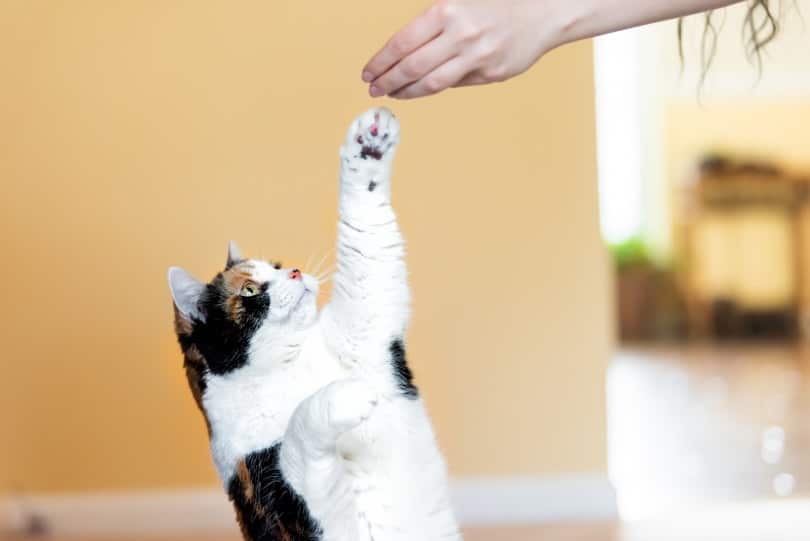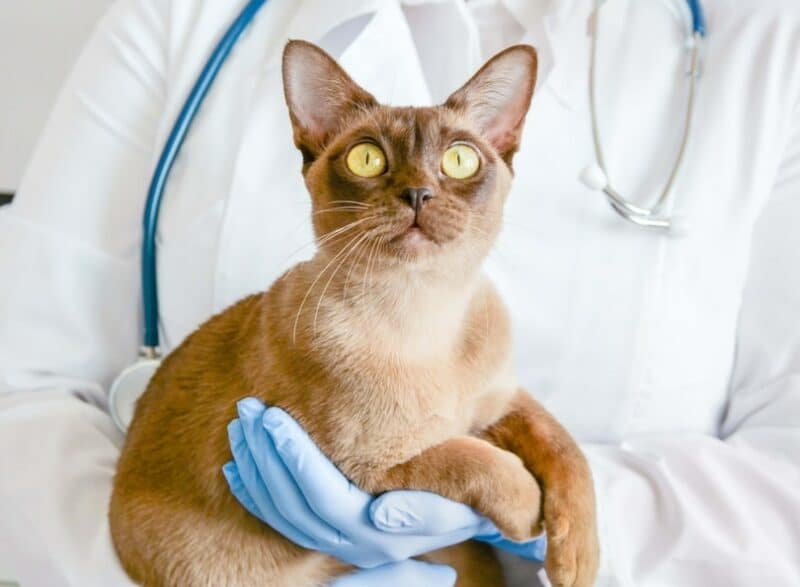If you’re a cat person who is interested in becoming a guinea pig person or vice versa, you may be wondering if it’s safe to bring the two together. Do cats eat guinea pigs? The good news is that many cats won’t eat guinea pigs, and guinea pigs and cats can coexist peacefully if they remain separated, with each critter getting the attention and care that they need. However, you should be aware that there are risks associated with introducing cats and guinea pigs, so be sure to research both species and get to know their temperaments before making a decision.
The Risks of Cats and Guinea Pigs Living Together
Although cats and guinea pigs can often get along peacefully, there are still risks involved in bringing them together. Cats, especially if they’re not used to being around guinea pigs, may see the small creature as prey and attempt to chase or even attack it. They usually won’t eat it, but they may kill it if they have access to it.
Guinea pigs are also prone to stress and can easily become overwhelmed when confronted by larger animals like cats. It’s important to keep the two separated and introduce your cat to the guinea pig while the guinea pig is in its enclosure and your cat can’t get to it.
Also, cats can carry parasites that can make guinea pigs very sick. It’s important to ensure that your cat is regularly treated for fleas, ticks, and other parasites before introducing them to a guinea pig.

Making the Decision
Ultimately, whether it’s safe to keep cats and guinea pigs together will depend on their individual personalities. If you have an especially curious or predatory cat, it may be best to keep the two animals separated. Conversely, if your cats and guinea pigs are both easy-going creatures, they may be able to live together without any issues.
The best way to ensure success is to introduce them slowly and carefully. For example, give each animal their own room, and allow them to explore the other’s territory from a distance. This will help both animals become comfortable around one another without putting either of them in danger. If your cat does get close to the guinea pig and seems like they want to attack it, separate the two immediately.
The 6 Tips for Keeping a Cat and a Guinea Pig Together
It is possible to keep a cat and a guinea pig together, but it requires proper planning and patience. To ensure the safety of both animals, it is important to introduce them carefully and gradually. Here are some tips for keeping a cat and guinea pig together.
1. Provide Separate Living Spaces
Make sure that your cat and guinea pig have their own living spaces, such as a hutch or cage for the guinea pig so that it can feel safe and secure. You may even wish to keep the guinea pig in a room that your cat doesn’t have access to. This is an essential first step in preventing the most basic types of conflicts between the two animals.

2. Monitor Interactions
When introducing your cat and guinea pig, it is important to monitor their interactions closely. If you notice any signs of aggression or fear from either animal, separate them immediately.
3. Train Your Cat
Training your cat can be beneficial in helping them understand how to interact with the guinea pig properly. You can use treats or toys as rewards when they show appropriate behavior around the guinea pig.

4. Provide Enrichment Activities
Provide enrichment activities such as puzzle feeders or hide-and-seek games for the guinea pig, and scratching posts or interactive toys for the cat. This will help keep your cat away from the guinea pig if both of them are entertained by other things.
5. Maintain Regular Vet Visits
Regular veterinary care is important for both animals to ensure they remain healthy and free of parasites and diseases. Make sure to take your cat and guinea pig to the vet at least once a year, or more frequently if recommended by your veterinarian.

6. Observe Behavior
Observing their behavior around each other will help you determine whether it’s safe to keep them together. If you notice any signs of aggression or fear from either of the animals, it may be best to separate the two animals. Be prepared to separate the cat and guinea pig if necessary. Have a separate room or space ready in case you need to quickly remove one animal from the other’s presence.
Following these tips can help ensure that your cat and guinea pig stay safe and happy when living together. With the right precautions, the two animals can form a strong bond and even become best friends!
How Can I Tell If My Cat Is Stressing Out My Guinea Pig?
To tell if your cat is stressing out your guinea pig, pay attention to both animals’ behavior. If the guinea pig becomes easily startled or starts acting aggressively toward the cat, this may be a sign of distress. Other signs of stress in guinea pigs can include trembling, vocalizing, and excessive grooming.
Additionally, the guinea pig may stress out your cat instead of the other way around. Signs of stress in cats can include hiding, excessive grooming, and vocalizing. If you notice any of these behaviors from either animal, it is best to separate the two animals until you can consult with a veterinarian.

 FAQ
FAQ
Is It Okay for My Cat to Sleep Near My Guinea Pig?
This is not recommended. Limit interactions to when they are awake so you can observe them fully. Guinea pigs should also be safely enclosed in their cage during the night.
Can My Guinea Pig and Cat Play Together?
As long as they have been properly socialized, cats and guinea pigs can play together if they are comfortable around each other and your cat doesn’t actively try to prey on your guinea pig. However, be sure to supervise their interactions closely to prevent any accidents or incidents of aggression.
Is There Any Other Advice to Keep in Mind When Keeping a Cat and a Guinea Pig Together?
Guinea pigs should be housed in an enclosure and if you have a cat, that means ensuring the top of their enclosure can be shut securely when you are not present. They are two different animals with varied needs and instincts, and interspecies relationships are not bonds that can be forced. We do not recommend cats and guinea pigs live freely among one another and should always be supervised if you want there to be direct contact between the two.
It is also important to note that if one cat fares well with your guinea pigs, that doesn’t mean other cats will. Protecting your guinea pig from any potential danger, harm or emotional distress should be a top priority.
Remember to provide plenty of safe spaces for both animals. Cats should have access to high perches or shelves that the guinea pig can’t reach, and the guinea pig should have access to tunnels, huts, and other hiding spaces that the cat can’t reach. Additionally, provide plenty of chew toys for the guinea pig to help keep their teeth healthy. Finally, make sure to clean both enclosures regularly with non-toxic cleaning products.
Conclusion
With the proper care and precautions, cats and guinea pigs can often live together peacefully. It is important to be aware of the risks involved and to be mindful of each animal’s individual personality and keep a close eye on them in order to ensure their safety. With patience and understanding, cats and guinea pigs can coexist happily! However, if your cat shows any signs of aggression, separate the animals immediately. Never force interactions.
Featured Image Credit: BunionBear, Shutterstock
Contents
- The Risks of Cats and Guinea Pigs Living Together
- Making the Decision
- The 6 Tips for Keeping a Cat and a Guinea Pig Together
- 1. Provide Separate Living Spaces
- 2. Monitor Interactions
- 3. Train Your Cat
- 4. Provide Enrichment Activities
- 5. Maintain Regular Vet Visits
- 6. Observe Behavior
- How Can I Tell If My Cat Is Stressing Out My Guinea Pig?
- FAQ
- Is It Okay for My Cat to Sleep Near My Guinea Pig?
- Can My Guinea Pig and Cat Play Together?
- Is There Any Other Advice to Keep in Mind When Keeping a Cat and a Guinea Pig Together?
- Conclusion





 FAQ
FAQ







